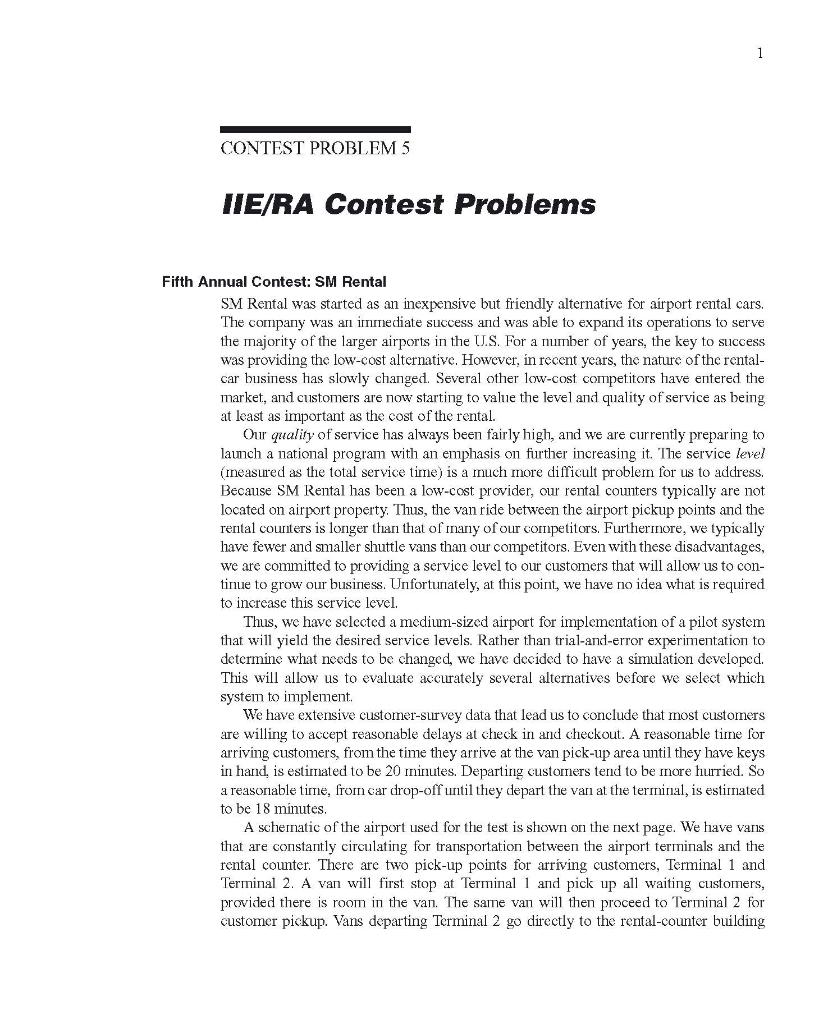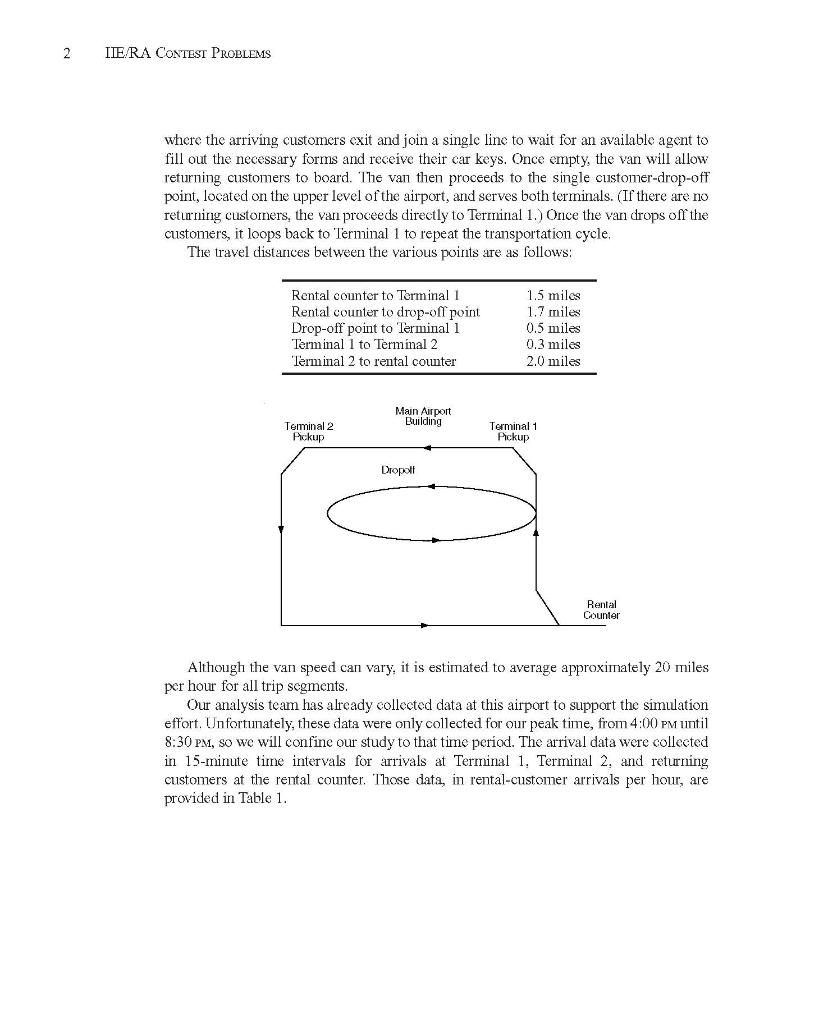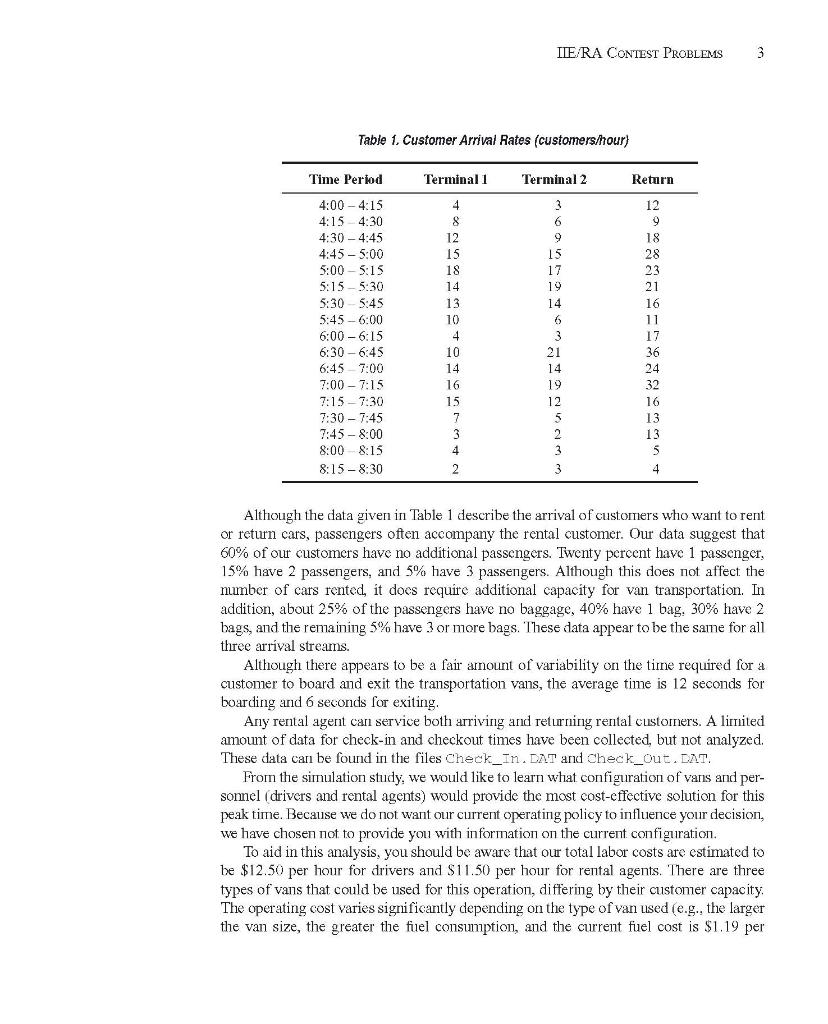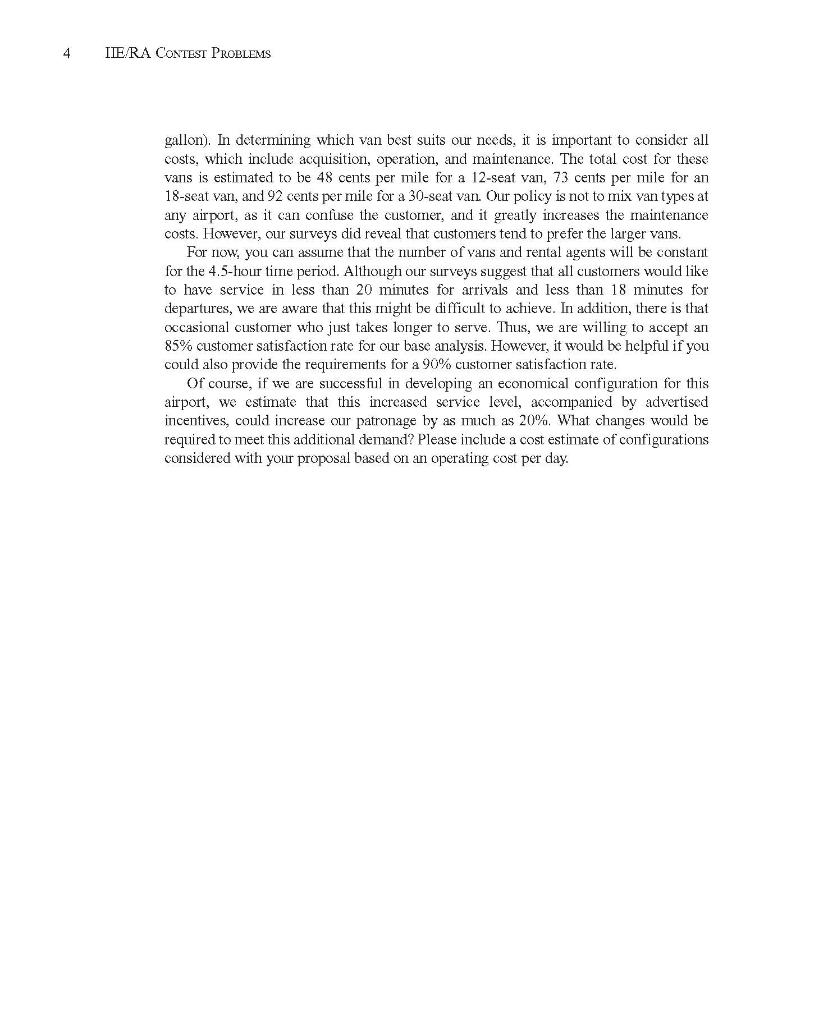Answered step by step
Verified Expert Solution
Question
1 Approved Answer
SOLVE IN ARENA SIMULATION 1 CONTEST PROBLEM 5 IIE/RA Contest Problems Fifth Annual Contest: SM Rental SM Rental was started as an inexpensive but friendly




SOLVE IN ARENA SIMULATION
1 CONTEST PROBLEM 5 IIE/RA Contest Problems Fifth Annual Contest: SM Rental SM Rental was started as an inexpensive but friendly alternative for airport rental cars. The company was an immediate success and was able to expand its operations to serve the majority of the larger airports in the US. For a number of years, the key to success was providing the low-cost alternative. However, in recent years, the nature of the rental- car business has slowly changed Several other low-cost competitors have entered the market, and customers are now starting to value the level and quality of service as being at least as important as the cost of the rental. Our quality of service has always been fairly high, and we are currently preparing to launch a national program with an emphasis on further increasing it. The service level (Ineasured as the total service time) is a much more difficult problem for us to address. Because SM Rental has been a low-cost provider, our rental counters typically are not located on airport property. Thus, the van ride between the airport pickup points and the rental counters is longer than that of many of our competitors. Furthermore, we typically have fewer and smaller shuttle vans than our competitors. Even with these disadvantages, we are committed to providing a service level to our customers that will allow us to con- tinue to grow our business. Unfortunately, at this point, we have no idea what is required to increase this service level. Thus, we have selected a medium-sized airport for implementation of a pilot system that will yield the desired service levels. Rather than trial-and-error experimentation to determine what needs to be changed, we have decided to have a simulation developed. This will allow us to evaluate accurately several alternatives before we select which system to implement We have extensive customer-survey data that lead us to conclude that most customers are willing to accept reasonable delays at check in and checkout. A reasonable time for arriving customers, from the tine they arrive at the van pick-up area until they have keys in hand, is estimated to be 20 ininutes. Departing customers tend to be more hurried. So a reasonable time, from car drop-off until they depart the var at the terminal, is estimated to be 18 minutes A schernatic of the airport used for the test is shown on the next page. We have vans that are constantly circulating for transportation between the airport terminals and the rental counter. There are two pick-up points for arriving customers, Terminal 1 and Terminal 2. A van will first stop at Terminal 1 and pick up all waiting customers, provided there is room in the van. The same van will then proceed to Terminal 2 for customer pickup. Vans departing Terminal 2 go directly to the rental-counter building 2 IIERA CONTEST PROBLEMS where the arriving customers exit and join a single line to wait for an available agent to fill out the necessary forms and receive their car keys. Once empty, the van will allow returning customers to board. The van then proceeds to the single customer-drop-off point, located on the upper level of the airport, and serves both terminals. (If there are no returning customers, the van proceeds directly to Terminal 1.) Once the van drops off the customers, it loops back to Terminal 1 to repeat the transportation cycle. The travel distances between the various points are as follows: Rental counter to Terminal 1 Rental counter to drop-off point Drop-off point to Terminal i Terminal 1 to Terminal 2 Terminal 2 to rental counter 1.5 miles 1.7 miles 0.5 miles 0.3 miles 2.0 miles Main Airport Building Terminal 2 Pickup Terminal 1 Pickup Droport Rental Counter Although the van speed can vary, it is estimated to average approximately 20 miles per hour for all trip segments. Our analysis team has already collected data at this airport to support the simulation effort. Unfortunately, these data were only collected for our peak time, from 4:00 pm until 8:30 PM, So we will confine our study to that time period. The arrival data were collected in 15-minute time intervals for arrivals at Terminal 1, Terminal 2, and returning customers at the rental counter. These data, in rental-customer arrivals per hour, are provided in Table 1. IIERA CONTEST PROBLEMS 3 Table 1, Customer Arrival Rates (customers/hour) Time Period Terminal 1 Terminal 2 Return 6 9 12 9 18 28 23 4:00-4:15 4:15 4:30 4:30-4:45 4:45 - 5:00 5:00 5:15 5:15-5-30 5:30 5:45 2:35:45 5:45-6:00 6:00-6:15 6:30 -645 6:457:00 7:00 - 7:15 7:15 - 7:30 7:30 - 7:45 7:45-8:00 8:00 8:15 8:15-8:30 4 8 12 15 18 14 13 12 10 10 4 + 10 TU 14 14 16 16 15 15 7 15 17 19 14 6 3 21 21 14 19 12 16 11 17 36. 24 24 32 16 13 13 5 4 3 4 2 Although the data given in Table 1 describe the arrival of customers who want to rent or return cars, passengers often accompany the rental customer. Our data suggest that 60% of our customers have no additional passengers. Twenty percent have 1 passenger, 15% have 2 passengers, and 5% have 3 passengers. Although this does not affect the mmber of cars rented, it does require additional capacity for van transportation. In addition, about 25% of the passengers have no baggage, 40% have 1 bag, 30% have 2 bags, and the remaining 5% have 3 or more bags. These data appear to be the same for all three arrival streams. Although there appears to be a fair annount of variability on the time required for a customer to board and exit the transportation vans, the average time is 12 seconds for boarding and 6 seconds for exiting, Arly rental agent can service both arriving and returning rental customers. A limited amount of data for check-in and checkout times have been collected, but not analyzed. These data can be found in the files Check_in.DAT and Check_out.DAT. From the simulation study, we would like to learn what configuration of vans and per- somel (drivers and rental agents) would provide the most cost-effective solution for this peak time. Because we do not want our current operating policy to influence your decision, we have chosen not to provide you with information on the current configuration. To aid in this analysis, you should be aware that our total labor costs are estimated to be $12.50 per hour for drivers and $11.50 per hour for rental agents. There are three types of vans that could be used for this operation, differing by their customer capacity, The operating cost varies significantly depending on the type of van used (e.g., the larger the van size, the greater the fuel consumption, and the current fuel cost is $1.19 per 4 IIERA CONTEST PROBLEMS gallon). In determining which van best suits our needs, it is important to consider all costs, which include acquisition, operation, and maintenance. The total cost for these vans is estimated to be 48 cents per mile for a 12-seat van, 73 cents per mile for an 18-seat van, and 92 cents per mile for a 30-seat van. Our policy is not to mix van types at any airport, as it can confuse the customer, and it greatly increases the maintenance costs. However, our surveys did reveal that customers tend to prefer the larger vans. For now, you can assune that the nunber of vans and rental agents will be constant for the 4.5-hour time period. Although our surveys suggest that all customers would like to have service in less than 20 minutes for arrivals and less than 18 minutes for departures, we are aware that this might be difficult to achieve. In addition, there is that occasional customer who just takes longer to serve. Thus, we are willing to accept an 85% customer satisfaction rate for our base analysis. However, it would be helpful if you could also provide the requirements for a 90% customer satisfaction rate. Of course, if we are successful in developing an economical configuration for this airport, we estimate that this increased service level, accompanied by advertised incentives, could increase our patronage by as much as 20%. What changes would be required to meet this additional demand? Please include a cost estimate of configurations considered with your proposal based on an operating cost per day. 1 CONTEST PROBLEM 5 IIE/RA Contest Problems Fifth Annual Contest: SM Rental SM Rental was started as an inexpensive but friendly alternative for airport rental cars. The company was an immediate success and was able to expand its operations to serve the majority of the larger airports in the US. For a number of years, the key to success was providing the low-cost alternative. However, in recent years, the nature of the rental- car business has slowly changed Several other low-cost competitors have entered the market, and customers are now starting to value the level and quality of service as being at least as important as the cost of the rental. Our quality of service has always been fairly high, and we are currently preparing to launch a national program with an emphasis on further increasing it. The service level (Ineasured as the total service time) is a much more difficult problem for us to address. Because SM Rental has been a low-cost provider, our rental counters typically are not located on airport property. Thus, the van ride between the airport pickup points and the rental counters is longer than that of many of our competitors. Furthermore, we typically have fewer and smaller shuttle vans than our competitors. Even with these disadvantages, we are committed to providing a service level to our customers that will allow us to con- tinue to grow our business. Unfortunately, at this point, we have no idea what is required to increase this service level. Thus, we have selected a medium-sized airport for implementation of a pilot system that will yield the desired service levels. Rather than trial-and-error experimentation to determine what needs to be changed, we have decided to have a simulation developed. This will allow us to evaluate accurately several alternatives before we select which system to implement We have extensive customer-survey data that lead us to conclude that most customers are willing to accept reasonable delays at check in and checkout. A reasonable time for arriving customers, from the tine they arrive at the van pick-up area until they have keys in hand, is estimated to be 20 ininutes. Departing customers tend to be more hurried. So a reasonable time, from car drop-off until they depart the var at the terminal, is estimated to be 18 minutes A schernatic of the airport used for the test is shown on the next page. We have vans that are constantly circulating for transportation between the airport terminals and the rental counter. There are two pick-up points for arriving customers, Terminal 1 and Terminal 2. A van will first stop at Terminal 1 and pick up all waiting customers, provided there is room in the van. The same van will then proceed to Terminal 2 for customer pickup. Vans departing Terminal 2 go directly to the rental-counter building 2 IIERA CONTEST PROBLEMS where the arriving customers exit and join a single line to wait for an available agent to fill out the necessary forms and receive their car keys. Once empty, the van will allow returning customers to board. The van then proceeds to the single customer-drop-off point, located on the upper level of the airport, and serves both terminals. (If there are no returning customers, the van proceeds directly to Terminal 1.) Once the van drops off the customers, it loops back to Terminal 1 to repeat the transportation cycle. The travel distances between the various points are as follows: Rental counter to Terminal 1 Rental counter to drop-off point Drop-off point to Terminal i Terminal 1 to Terminal 2 Terminal 2 to rental counter 1.5 miles 1.7 miles 0.5 miles 0.3 miles 2.0 miles Main Airport Building Terminal 2 Pickup Terminal 1 Pickup Droport Rental Counter Although the van speed can vary, it is estimated to average approximately 20 miles per hour for all trip segments. Our analysis team has already collected data at this airport to support the simulation effort. Unfortunately, these data were only collected for our peak time, from 4:00 pm until 8:30 PM, So we will confine our study to that time period. The arrival data were collected in 15-minute time intervals for arrivals at Terminal 1, Terminal 2, and returning customers at the rental counter. These data, in rental-customer arrivals per hour, are provided in Table 1. IIERA CONTEST PROBLEMS 3 Table 1, Customer Arrival Rates (customers/hour) Time Period Terminal 1 Terminal 2 Return 6 9 12 9 18 28 23 4:00-4:15 4:15 4:30 4:30-4:45 4:45 - 5:00 5:00 5:15 5:15-5-30 5:30 5:45 2:35:45 5:45-6:00 6:00-6:15 6:30 -645 6:457:00 7:00 - 7:15 7:15 - 7:30 7:30 - 7:45 7:45-8:00 8:00 8:15 8:15-8:30 4 8 12 15 18 14 13 12 10 10 4 + 10 TU 14 14 16 16 15 15 7 15 17 19 14 6 3 21 21 14 19 12 16 11 17 36. 24 24 32 16 13 13 5 4 3 4 2 Although the data given in Table 1 describe the arrival of customers who want to rent or return cars, passengers often accompany the rental customer. Our data suggest that 60% of our customers have no additional passengers. Twenty percent have 1 passenger, 15% have 2 passengers, and 5% have 3 passengers. Although this does not affect the mmber of cars rented, it does require additional capacity for van transportation. In addition, about 25% of the passengers have no baggage, 40% have 1 bag, 30% have 2 bags, and the remaining 5% have 3 or more bags. These data appear to be the same for all three arrival streams. Although there appears to be a fair annount of variability on the time required for a customer to board and exit the transportation vans, the average time is 12 seconds for boarding and 6 seconds for exiting, Arly rental agent can service both arriving and returning rental customers. A limited amount of data for check-in and checkout times have been collected, but not analyzed. These data can be found in the files Check_in.DAT and Check_out.DAT. From the simulation study, we would like to learn what configuration of vans and per- somel (drivers and rental agents) would provide the most cost-effective solution for this peak time. Because we do not want our current operating policy to influence your decision, we have chosen not to provide you with information on the current configuration. To aid in this analysis, you should be aware that our total labor costs are estimated to be $12.50 per hour for drivers and $11.50 per hour for rental agents. There are three types of vans that could be used for this operation, differing by their customer capacity, The operating cost varies significantly depending on the type of van used (e.g., the larger the van size, the greater the fuel consumption, and the current fuel cost is $1.19 per 4 IIERA CONTEST PROBLEMS gallon). In determining which van best suits our needs, it is important to consider all costs, which include acquisition, operation, and maintenance. The total cost for these vans is estimated to be 48 cents per mile for a 12-seat van, 73 cents per mile for an 18-seat van, and 92 cents per mile for a 30-seat van. Our policy is not to mix van types at any airport, as it can confuse the customer, and it greatly increases the maintenance costs. However, our surveys did reveal that customers tend to prefer the larger vans. For now, you can assune that the nunber of vans and rental agents will be constant for the 4.5-hour time period. Although our surveys suggest that all customers would like to have service in less than 20 minutes for arrivals and less than 18 minutes for departures, we are aware that this might be difficult to achieve. In addition, there is that occasional customer who just takes longer to serve. Thus, we are willing to accept an 85% customer satisfaction rate for our base analysis. However, it would be helpful if you could also provide the requirements for a 90% customer satisfaction rate. Of course, if we are successful in developing an economical configuration for this airport, we estimate that this increased service level, accompanied by advertised incentives, could increase our patronage by as much as 20%. What changes would be required to meet this additional demand? Please include a cost estimate of configurations considered with your proposal based on an operating cost per dayStep by Step Solution
There are 3 Steps involved in it
Step: 1

Get Instant Access to Expert-Tailored Solutions
See step-by-step solutions with expert insights and AI powered tools for academic success
Step: 2

Step: 3

Ace Your Homework with AI
Get the answers you need in no time with our AI-driven, step-by-step assistance
Get Started


